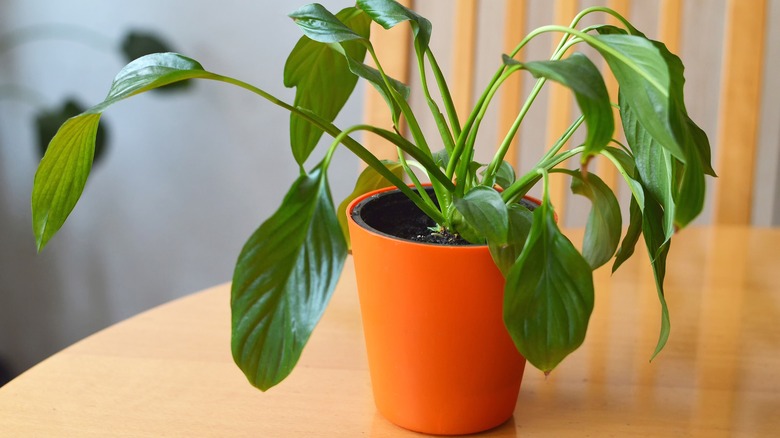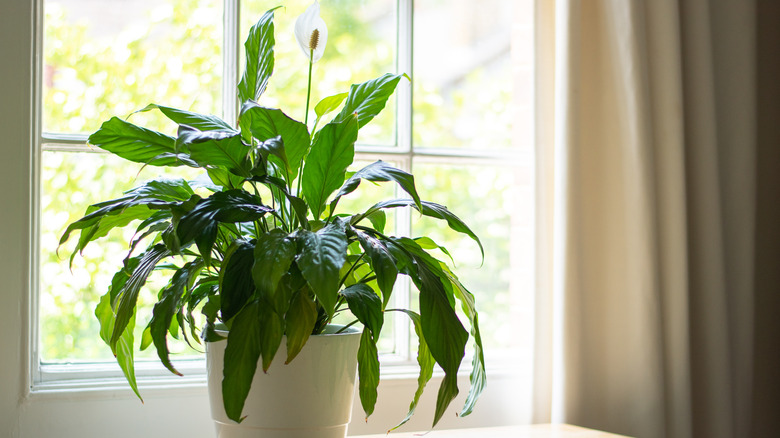Drama Queen Houseplants That Show You When They Are Feeling Neglected
Drama is not just for reality TV. Some plants are just as dramatic as all those tears on "The Bachelor," just without the emotional trauma. When our houseplants get theatrical, they express their feelings through their leaves instead of crying. Some greenery could even win an Emmy for their diva-like behavior. If a specific need is not met or they don't like their current residence, these plants will let you know. Some like to curl up, an action akin to folding one's arms and huffing. Others just flop over as if near death, crawling along the sandy desert toward the hallucination of an oasis, Looney Tunes style.
If you are new to growing these houseplants, don't be fooled by their antics. They just need something simple from you, as the plants on this list are not high-maintenance. In fact, several are considered some of the easiest houseplants to grow, in part because they show you something is wrong before they are knocking at death's door. Unlike some plants that look fine one week and are expired the next (looking at you, succulents), the green options on this list will rebound as soon as their needs are met.
Polka dot plant
Someone get this plant a fainting couch because that's what it likes to do. Imagine a plant version of Blanche Devereaux from "The Golden Girls" and you've got the polka dot plant (Hypoestes phyllostachya). This houseplant has vibrant pink and green foliage, although the pink portions of the leaves look less like polka dots and more like splotches. We suppose the "splotch plant" just doesn't have the same ring to it.
The polka dot plant gets first place on this list because of its dramatic reaction to dry soil. Many houseplants will droop a bit when their roots get dry, but this one goes the extra mile. After a few days of dry soil, it just falls over. The leaves and stem all wilt, making the plant look like it will never recover. Give it some water and in a few hours, it'll be right back to its glorious self, having forgiven you for your (not so) severe neglect.
Nerve plant
We love the nerve plant (Fittonia albivenis) because of the gorgeous contrast between its green leaves and bright white or pink veins. These veins resemble the nervous system, which is the inspiration for its name. This lovely little plant has a mounding growth habit and is safe for homes with cats and dogs. At maturity, nerve plants only reach about 6 inches tall, so they are perfect for small spaces like bookshelves or window sills.
Like the polka dot plant, the nerve plant is picky about the moisture in its soil. If you go away on vacation or get too busy to water your plants, this greenery will drop like a sack of potatoes. As long as you water your nerve plant soon after it begins its dramatic episode, it will perk back up. Try not to let the soil dry out too often. This will stress the plant, and at some point, it may stop recovering.
Prayer plant
The prayer plant (Calathea) is just overall dramatic. This plant's leaves curl in certain conditions, although you might have to practice some trial and error to find out why they are curling. Sometimes they curl when their soil is dry, the room is cold, or they are getting too much sunlight. Other times the problem may be soggy soil, lack of humidity, or too little sun. May the odds be ever in your favor. Sure, they can be a little dramatic and finicky, but once you find that sweet spot for your prayer plant, it will reward you with stunning foliage that includes a range of greens, pinks, and purples in interesting patterns.
Furthermore, this gorgeous plant isn't just dramatic when it's in less-than-ideal conditions, as it can be quite theatrical in its daily movement. Although it's not exactly dancing the can-can, the leaves move perceptively throughout the day. They open wide in the morning to welcome the light and close up when evening arrives. Calatheas wave their leaves in the air like they just don't care, and we love that about them.
Peace lily
Peace lilies (Spathiphyllum wallisii) require very little maintenance, and their light requirements are minimal; however, they could be considered the Debbie Downer of houseplants. Mature peace lilies can reach around 4 feet tall. This means that, when their leaves droop, it's not just dramatic, it's extra sad. Thankfully, you can brighten your peace lily's day by giving it a good soak and keeping it in a pot with sufficient drainage. Soon after it gets the water it needs, your plant will reward you by returning to its previous upright position, complete with full glossy leaves.
These plants like consistently moist soil but not soggy roots. Regular watering from the bottom is ideal for peace lilies. You can place a large planter in the bathtub with a few inches of room temperature water or put smaller pots in a bowl. Remove the plant from the water once the top layer of soil is moist, then let any excess water drain out. Doing this any time the soil is dry 1 inch below the surface will ensure your peace lily does not have to be dramatic to get your attention.
Pothos
The pothos plant (Epipremnum aureum) is certainly among one of the easiest plants to grow almost anywhere. They tolerate bright indirect light indoors but are also among the few plants that thrive in low-light conditions. Pothos plants are even very forgiving about dry soil, but their patience will eventually run out. At this point, you can probably guess what happens when they stay too dry for too long. Yep, they droop. They are not as dramatic as the fainting polka dot plant and they won't do a full greenery collapse like a peace lily, but one day your pothos will look perfectly healthy, and the next every single leaf on the plant will droop in solidarity against the forces that have caused this travesty.
Like the other plants on our list, a droopy pothos just needs some water to perk back up, but beware: this negligence will not be tolerated indefinitely. Should these long dry spells become a recurring problem, your pothos will still probably survive, but it will give you leaves that turn yellow and dry. Just to make sure you do not forget your offenses, those leaves will not be replaced. There will forever be a bald spot, so always remember to regularly water your pothos.





